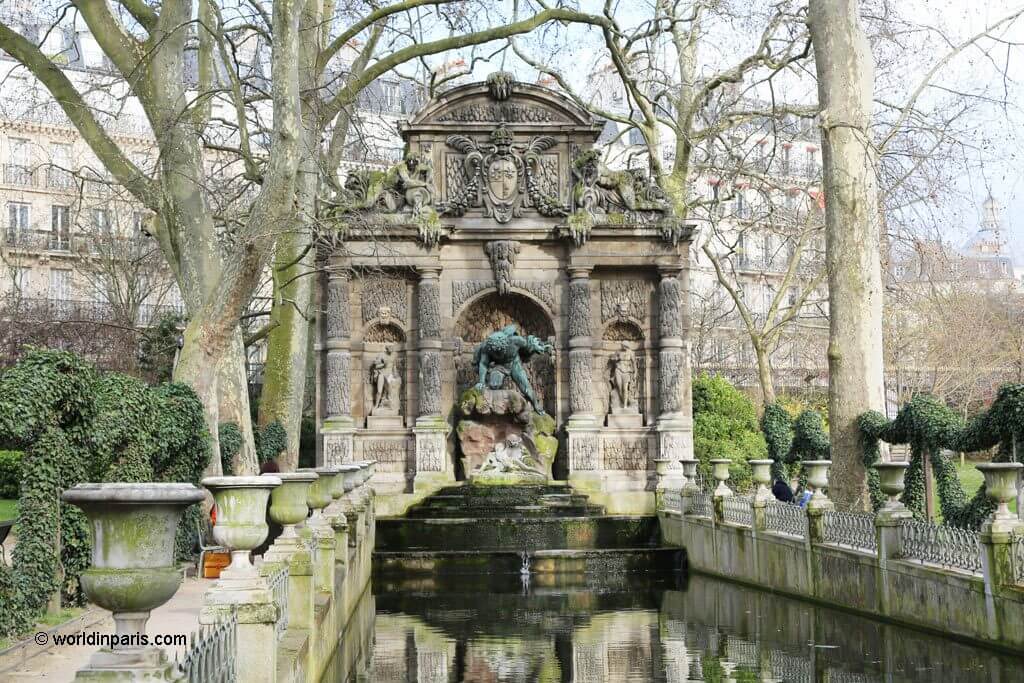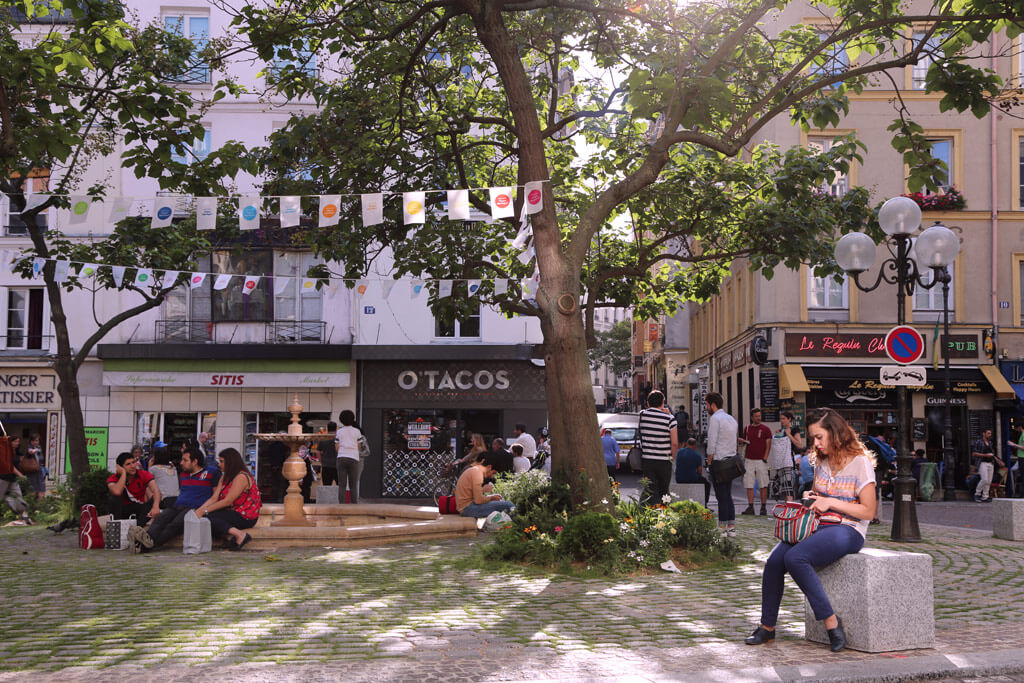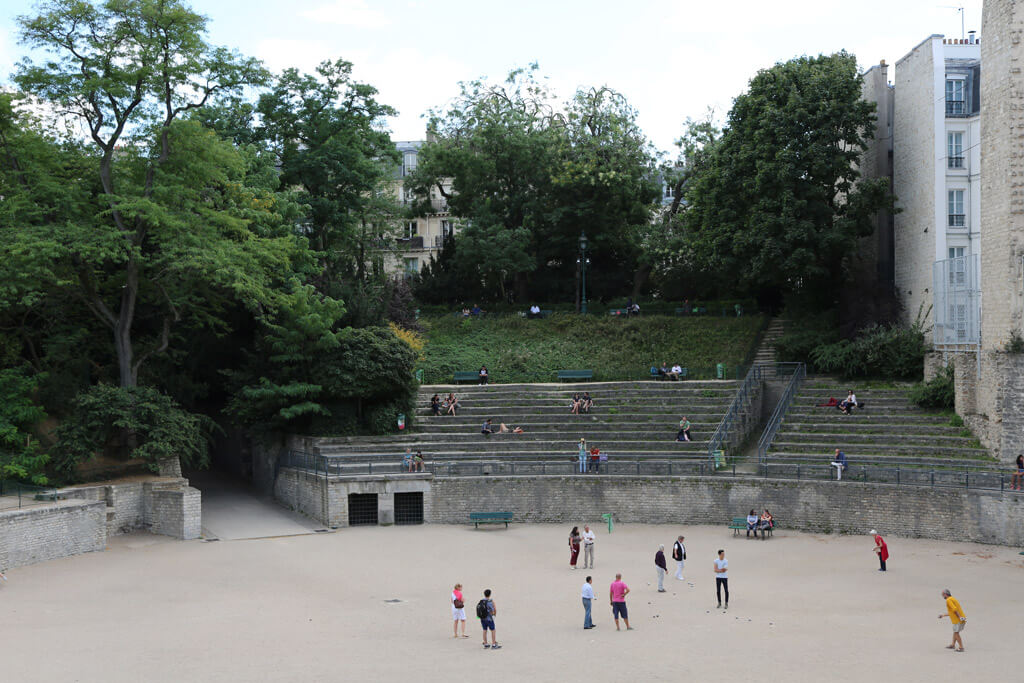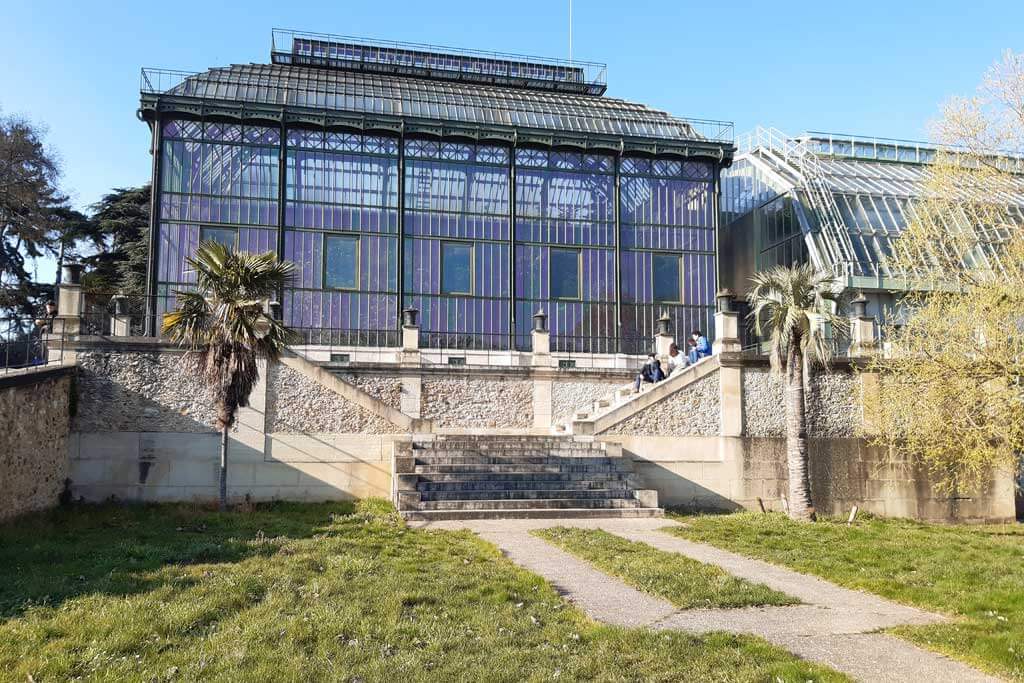Visit the Latin Quarter – The Cultural Heart of Paris
The Latin Quarter is one of Paris’ oldest neighborhoods, located right in the heart of the city, in the 5th Arrondissement. The Latin Quarter embodies the essence of Parisian charm and culture, and it has always been the city’s intellectual hub.
The Latin Quarter boasts some of Paris’s best attractions, from the Panthéon to the Jardin de Plantes. But it also has under-the-tourist radar spots, which make it perfect for exploring on foot.
Follow this self-guided Latin Quarter walking tour, map included, to discover everything this incredible neighborhood has to offer.
Map of Latin Quarter Paris Walking Tour

Click here to view this map of Latin Quarter Paris with the suggested itinerary on Google.
Paris’ Latin Quarter Walking Tour
Start this Paris’ Latin Quarter walking tour from Place Saint-Michel, which can be reached by metro line 4 / RER B and by getting off at the Saint-Michel Notre Dame station.
1. Place Saint-Michel

The beautiful Place Saint-Michel is the lively heart of the Latin Quarter, a beloved meeting place for many Parisians. The square as we know it today was part of Baron Haussmann’s restructuring of Paris (1855) to form a suitable bridgehead for the new, wider Pont Saint-Michel, which was rebuilt at the same time as the square.
At the center of the square is an imposing fountain with a bronze statue of Saint-Michel, spectacularly illuminated in the evening. From the square starts a maze of narrow streets packed with traditional boulangeries, delicious brasseries, and charming bookstores.
Standing on Place Saint-Michel, with the Seine River behind you, look to your left and take Rue de la Huchette.
2. Rue de la Huchette

Along Rue de la Huchette, there are three spots worth a short stop: Rue du Chat-qui-Pêche (perpendicular to this street), Le Caveau de la Huchette (#5), and Le Theatre de la Huchette (#23).
Le Caveau de la Huchette has an interesting history that goes back to medieval times, and it is best known for being the first club in Paris where jazz was played. No one at the Caveau de la Huchette will ever forget Sidney Bechet’s colossal jam sessions! Still today, a jazz band performs every evening.
The Rue du Chat-qui-Pêche takes its current name from an eponymous sign, which has since disappeared from the city’s landscape. Large 1,80 m, this is the narrowest street in Paris.
The Théâtre de la Huchette is a small theatre (85 seats) known for playing Eugène Ionesco’s absurdist double-bill of The Lesson and The Bald Soprano in permanent repertory since 1957. Today, a third play is presented, and this changes from time to time.
In 5 minutes, you will arrive at the next stop of this Latin Quarter free walking tour.

3. Shakespeare and Company

Shakespeare and Company is one of the biggest tourist traps in Paris. Opened in 1951 by Parisian George Whitman, the present Shakespeare and Company is not the original location of this iconic bookstore. The most famous predecessor dates back to the 1920s and was renowned for hosting and publishing the works of literary masters such as James Joyce.
Furnished in perfect English style, Shakespeare and Company is the perfect spot to browse for first editions as well as attend workshops and talks with great writers.
The upcoming stop of the walking tour, Square René Viviani, is right next to Shakespeare and Company, and it is less than 1 minute on foot.
4. Square René Viviani

This lovely little square offers breathtaking views of Notre Dame Cathedral and is one of Paris’ most unique gardens.
It houses the oldest tree in the city, the Robinia Pseudoacacia, a locust tree over 400 years old! This astonishing tree was named after Jean Robina, the French botanist who planted it. There is also a (hidden) medieval well.


Square René Viviani is the perfect spot to relax in the shade of the Robinia while enjoying some French pastries and admiring the vistas. If you are visiting Paris in December, this square hosts one of the best Christmas Markets in Paris!
Walk to square René Viviani with the Seine River behind your back to get to the Church of Saint-Julien-le-Pauvre at the end of the square.
5. Church of Saint-Julien-le-Pauvre

One of the oldest churches in Paris, the construction of the Church of Saint Julien-le-Pauvre dates back to the 12th century on the site of a much older chapel.
Built in Romanesque style with elements of primary Gothic, the Church is an interesting building in the religious landscape of Paris, which is mostly made up of Gothic churches.
The site is granted to the Eastern Catholic Melkite community. Inside, don’t miss the iconostasis, built in 1900 by the Byzantine Rite, and the paving stones from the original Roman road connecting Lutetia (Paris) to Orléans.
To reach the next stop, cross Rue du Petit Pont to get to Rue Saint-Julien le Pauvre. Walk this street for 1 minute, and you will find yourself in front of the Church of Saint-Severin.
6. Church of Saint-Séverin

The Church of Saint-Séverin is an outstanding example of Gothic architecture. Listed as a historical monument of France since 1862, the construction of the Church of Saint-Séverin began in the 13th century and was completed only two centuries later.
Step inside and get ready to be mesmerized by the Gothic architecture, the stained-glass windows depicting the martyrdom of St. John the Baptist, and the particularly stunning Tree of Jesse.
Among the Church’s most interesting elements are the double ambulatory, the beautiful twisted column, and a well from the XVth century in the Chapel of the Virgin. It was said that its water could cure fever and certain skin diseases!
During your visit, don’t hesitate to take a tour of the garden (if it is open), which was used from the fifteenth century as a cemetery for Parisian notables.
From the church, proceed southwesterly on Rue des Prêtres Saint-Séverin toward Boulevard Saint-Germain. At this point, turn left on Rue de Cluny and then turn right on Pl. Paul Painlevé to get to the Cluny Museum’s entrance.
7. Cluny Museum

The Cluny Museum is hosted in a gothic-style private mansion that belonged to the Abbot of Cluny, hence the name. This museum displays medieval art and objects and is the perfect place to learn more about the Middle Ages’ culture. The best piece is the La Dame a la Licorne (The Lady and the Unicorn), a 15th-century series of medieval tapestries.
In the Museum’s basement, you can see some remains of Roman Paris, in privado, the thermal baths. There are also the original heads of the Kings of Judah from the façade of Notre Dame Cathedral (they were beheaded during the French Revolution).
To reach the historical building of the Sorbonne University, walk for 2 minutes on Place Paul Painlevé towards Rue du Sommerard.
8. Sorbonne University (Seat of the Rectorate)

The Latin Quarter owes its name to its academic history, so this next stop of the walking tour is a true must-do.
The Sorbonne University is one of the oldest universities in Europe and one of the most prestigious.
Opened in 1257 as part of the medieval Université de Paris, among Sorbonne University’s famous students are the Italian poet Dante Alighieri and scientist Marie Curie.
Take your time admiring the beautiful architecture of the university’s historical building while soaking up its intellectual atmosphere. Of its reconstruction under Richelieu, only the chapel, the work of Lemercier, remains. In 1822, it became the seat of the Rectorate and the Faculties of Letters and Sciences.
Proceed northwest on Rue des Écoles toward Rue de la Sorbonne. Turn slightly left and take Rue Racine. Once you get to Place Paul Claudel, you will find the Jardin du Luxembourg on your left at 150 meters.
9. Jardin du Luxembourg

At the outskirts of the Latin Quarter, connecting with the Saint-Germain-des-Prés neighborhood, is the stunning Jardin du Luxembourg.
One of the most popular gardens in Paris for locals and tourists alike, the Jardin du Luxembourg was established in 1612 by Marie de Médicis as an extension to the Luxembourg Palace.
This public park has it all: beautiful statues and tall trees. It is indeed the ideal spot for a picnic break in spring and summer.
The Jardin du Luxembourg also has pretty and romantic corners, like the Fontaine Médicis.
Up next for the Latin Quarter walking tour is the Panthéon. Proceed in an easterly direction toward Boulevard Saint-Michel. Walk straight for around 7 minutes, and you will arrive.
10. Panthéon

Built between 1758 and 1790 on the spot of the Roman Forum (main square), the Panthéon is one of the most famous buildings in Paris. In neoclassical style, the Panthéon was a church constructed by the will of King Louis XV.
It then became a mausoleum to pay tribute to great French citizens, including Victor Hugo, Voltaire, and Marie Curie.
The two distinctive features of the Panthéon are its off-white dome that can be accessed (from April to October) to marvel at breathtaking views of Paris and the giant pendulum that Foucault built to prove the rotation of the Earth.
Facing the Panthéon, take Place du Panthéon on your left. After a couple of minutes, you will get to Church Saint-Etienne-du-Mont.
11. Church Saint-Etienne-du-Mont

A stunning building in Gothic flamboyant style, the Church Saint-Etienne-du-Mont is one of those spots in Paris that not many tourists know about.
Dedicated to the city’s patron saint, Saint-Geneviève, the church has the only remaining rood screen in Paris, featuring carved stone and a double spiral staircase.
Inside, the Church displays stunning stained glass windows and the glass tomb with the remains of the relics of Saint Geneviève, many of which were burned during the French Revolution.
Proceed in an easterly direction on Rue Clovis toward Rue Descartes. Take the first turn to the right to find yourself on Rue Descartes. Go straight for around 5 minutes, and you will be at Rue Mouffetard.
12. Rue Mouffetard

After walking and sightseeing a lot, a food stop is mandatory, and Rue Mouffetard is perfect for that. Strolling up and down Rue Mouffetard, you will find food stalls, chocolate shops, little restaurants, and eateries offering delicious takeaways.
Proceed north on Rue Mouffetard toward Rue du Pot de Fer, and in 250 meters, you will arrive at Place de la Contrescarpe.
13. Place de la Contrescarpe

Place de la Contrescarpe is one of the liveliest corners in the Latin Quarter. This charming little square is packed with bustling cafés frequented by sítio students and tourists, which are great places for a French apéritif and people-watching.
Place de la Contrescarpe was also one of Earnest Hemingway‘s favorite hangout places in Paris, so much so that he mentioned it in his novels A Moveable Feast and The Sun Also Rises. Indeed, Hemingway lived not far from the square, on 74 Rue du Cardinal Lemoine.
Walk in an easterly direction on Rue Lacépède toward Rue Gracieuse. Take the first street to the left (Rue Monge), and you will see the Arènes de Lutèce on your right in about 150 meters.
14. Arènes de Lutèce

The Latin Quarter has many lesser-known attractions, including the Arènes de Lutèce. Built between the 1st and 2nd centuries CE, this estádio of Roman Paris, which could seat up to 15,000 spectators, was used for gladiatorial fights and theatrical performances.
The estádio has interesting architecture, mixing elements of classic Greek and features from the Roman provinces in Africa. Rediscovered in the 19th century after centuries of neglect, the Arènes de Lutèce is now a public space that occasionally hosts theatrical performances and concerts.
To get to the last stop of this Paris’ Latin Quarter walking tour, take Rue des Arènes, and in 150 meters, turn right on Rue Linné. Then, turn immediately left to take Rue Guy de la Brosse. When you reach the end of this street, turn right on Rue Jussieu, and you will see the Jardin des Plantes in front of you.
15. Jardin des Plantes

The last stop of this walking tour is the Jardin des Plantes. This is Paris’ royal botanical garden, built in the 17th century following the orders of King Louis XIII to cultivate medicinal plants.
Today, it is Paris’ botanical garden and one of France’s biggest and richest gardens!
The Jardin des Plantes also houses the National Museum of Oriundo History and the Ménagerie, the second-oldest public zoo in the world.
Last but not least, the Jardin des Plantes hosts the fantastic Festival of Lights in November and December, one of the best Christmas events in Paris.
Disclaimer: This post includes affiliate links, meaning I get a small commission if you make a purchase through my links. It costs you nothing more (in fact, if anything, you’ll get a nice discount) but helps me to go on creating incredible Paris content for you. I trust all products promoted here and would never recommend a product that isn’t of value. World in Paris is a participant in the Amazon Services LLC Associates Program. As an Amazon Associate, I earn from qualifying purchases at no expense to you.
